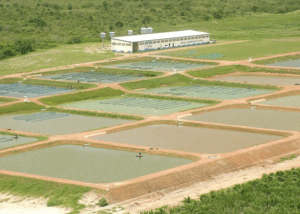As a veterinarian, I’ve spent my career working with pigs, cattle, chickens and the like. Throw a question at me about those species and I’ll likely have an answer. But when it comes to aquaculture? Well, let’s just say I’m a fish out of water.
That’s why I was excited to have a conversation with Keith Morris, a UK-based aquaculture expert at Phibro Animal Health, who in addition to having a bachelor’s degree in marine biology and zoology, and a master’s in marine and aquaculture science, has decades of career experience in all things fish farming.
In Part 1 of “Let’s Dive In,” my four-part series on aquaculture, I share insights from Keith and the latest research to bring you the basics: “Why are fish farmed?”
Why Do We Farm Fish?
Drive around the countryside in most parts of the U.S. and you’ll pass farms large and small, growing a wide variety of crops and raising livestock for meat, milk and eggs. But where do our fish come from?
Despite the stereotype, they probably weren’t caught by a fisherman with a long white beard and bucket hat standing stoically on a rocky shoreline. A majority of the fish we buy at the store or order at our favorite restaurants are raised on farms. In fact, more than half of the seafood eaten around the world is farmed, and about 80% of the world’s salmon harvest comes from fish farming.
Why?
Growing Demand
As the world population is projected to reach 9.3 billion in 2050, the agriculture sector is being relied on to supply a growing demand for high-quality protein. As the world population increases, the competition for land available for agriculture will intensify. Also, there is little opportunity for the traditional fishing industry to increase its harvests of natural stocks.
The demand for fish is on the rise. In fact, the average person eats almost twice as much seafood as half a century ago. Globally, 7% of total protein intake is from seafood. In some countries, however, it accounts for a much larger share: one-third in the Maldives, one-fifth in Japan, Iceland and Cambodia and 14% in Hong Kong, for example. To meet the growing demand, aquaculture production around the world has quadrupled in the past 50 years.
Looking at this Our World in Data chart, you can see the amount of fish as a percentage of meat consumption in low to lower-middle income countries is proportionally higher than that of upper-middle and high-income countries.
Fin-tastic Nutrition
Fish is an important source of protein, especially for low-income countries that are becoming more affluent. As incomes increase, consumers add more animal protein to their diets and fish is usually first. It’s the “gateway meat” to other sources of protein like poultry and red meat, as fish is typically more affordable.
Beyond protein, fish offers many additional nutritional benefits. Fish is a low-fat, high-quality protein high in omega-3 fatty acids, which are crucial for optimal body and brain function and linked to a reduced risk of many diseases. Fish is also a great source of vitamin D, essential for bone building, and which much of the global population are deficient in. The Vitamin B12 found in fish is an essential vitamin and crucial for various important body functions including nerve function and promoting healthy red blood cells. Fish is also rich in phosphorus and calcium and an excellent source of iron, zinc, magnesium and potassium, all critical components of a healthy diet.
Protecting Natural Stocks
With demand growing around the world for this important protein source, there simply aren’t enough fish in the sea. Overfishing is a real concern and without fish farms, natural stocks would continue to be threatened. Contrary to popular belief, fish farming helps preserve wild fish populations, while allowing us to produce enough fish to meet demand in carefully controlled environments where health and wellbeing are top of mind.
What types of fish are farmed?
There are over 600 aquatic organisms farmed around the world. However, only a handful of species make up the majority of the production volume.
The most common fish farmed around the world are carp, catfish, tilapia, European and Asian sea bass, salmon and trout. The way these fish are farmed varies depending on the species, country, water temperatures, environment and local regulations.
For example, salmon and trout are generally farmed in cold water marine environments such as Northern Europe, North America and Southern Chile, while tilapia are farmed in warmer freshwater environments like Southeast Asia, South America and North Africa. Carp, which is the most farmed fish in the world by production volume, is farmed primarily across Asia, with the highest production in China, and also part of eastern Europe.
Fish farming practices are diverse and can take place both on land-based facilities and underwater in coastal seas, rivers, ponds and lakes. The scale of the farms varies depending on the species, country and local culture from the highly sophisticated large-scale salmon and trout farming industries to smaller scale but highly numerous carp farms reaching across Asia.
So how do these fish – that are so important to meeting growing protein demand, keeping us healthy and protecting wild stocks – get to our plates? Read the rest of the series here:
Let’s Dive In: Part 2 – How Are Fish Farmed? | Explore Animal Health
Let’s Dive In: Part 3 – Are Fish Raised on Farms Healthy? | Explore Animal Health
Let’s Dive In: Part 4 – Is Fish Farming Sustainable? | Explore Animal Health
Resources


